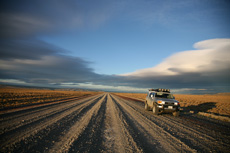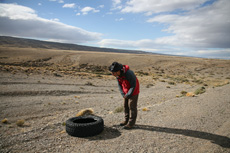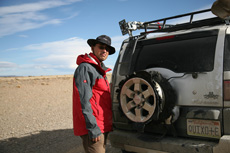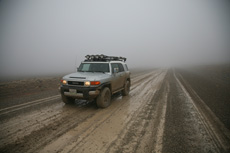
|
|
Shredded tire |
Asphalt – Going off road – Driving gravel – Ruta 40 – From Dr. Jekyll to Mr. Hyde. (Map this!)
We forget what a miracle asphalt is. Just as the internet revolutionized communications and reduced the world to a smaller size, asphalt (or tarmac) must have done the same in its time. We take it for granted and like hot water at the sink, we only notice when it is absent.
 |
|
Ruta 40 |
We have driven about 30,000 miles of all kinds of terrain, from snowy mountain roads of the Dempster to the rock strewn, rough roads of Panama. We didn’t take these roads deliberately, we did it because those were the only options available. We are not off roaders by heart, but by necessity.
Driving on these roads, however, does make you slow down and notice that which surrounds you. You absorb the long sunsets coloring the mountains rosy pink on the Dempster, or observe a fox nosing along the road. It makes you notice the caracaras perched on a fence post or the jabiru executing a graceful dance or the flamingoes painting a lake pink. It makes the journey longer, but also more interesting.
 |
|
Inspection |
Gravel roads have a nasty side too. They jolt every bolt in the car, stress the tires, muddy the exterior and undercarriage. Every time you put your car through this ordeal, you are supposed to tighten the bolts, get the mud and dirt off, check the tires. We try to be fairly scrupulous without being anal. But recently, we received an ugly reminder of just how bad gravel roads can be.
 |
|
Spare? |
It wasn’t the ruts in the Carretera Austral nor the potholes in Colombia. Neither was it the big rocks in Costa Rica. It was the famous Ruta 40 of Argentina that cuts through the desolate countryside of Patagonia that finally got us. Winds were fierce, the road was completely flat and straight and the car was almost swimming through the piles of gravel on the road.
WHAM! Suddenly I heard a terrible noise and saw a black, smoking ball rolling away in the side view mirror. “We just lost a tire”, Shreesh said. We struggled against the fierce wind to study the damage. Our tough Goodyear Mud-Terrain tire had just been ripped to shreds. Had we been going too fast? Had we aired down too much? Not enough? Or had one of the puncture patches on the tire blown?
 |
|
Mr. Hyde? |
We had to seek refuge in an Estancia that night. We camped in their backyard and ate the leftovers from a tour group staying there. It rained all night. The next day, the road had suddenly become a river of mud. Thick fog descended. Hardly any cars could be seen on the road. We crawled along at 20mph, hoping we wouldn’t need a spare.
The road, a relatively innocuous Dr Jekyl, had just morphed into Mr. Hyde.
Sounds hideous and possibly dangerous. So what was the outcome?
Can’t you just call AAA like in Uganda?
Neena and Shreesh,
How did you mange to get back to the regular tires? As Fred wrote, is there AAA service in Patagonia? Has the rain subsided now?
Aai
It was tough getting the spare tire back on. The normal jack did not fit under the car because the tire had sloughed off so we had to be inventive; the high-lift jack was broken – a bolt fell off during the rough ride and we couldn’t use it either!
No AAA to call out on Ruta 40 in Argentina – we can’t even find a spare out in Calafate (one of the biggest towns), so we will have to wait till Punta Arenas. Things are holding together so far, but tough going on these roads without a spare. Traveling very slow!!!
Luckily the tough part is over, mostly asphalt from here on out.